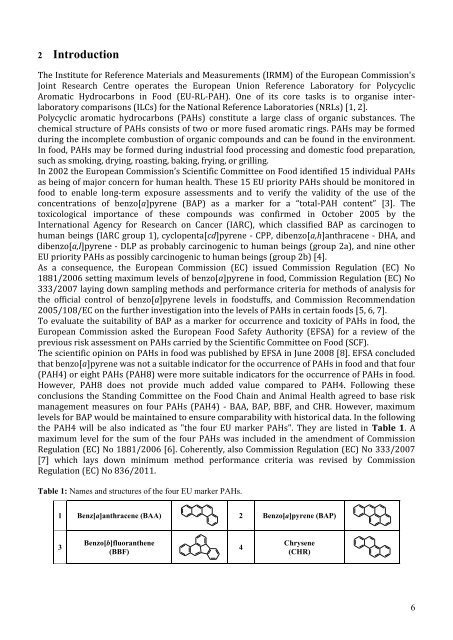jrc79301_report%20eu-rl%20pahs%20pt%20on%20chocolate%202012_ver11
jrc79301_report%20eu-rl%20pahs%20pt%20on%20chocolate%202012_ver11
jrc79301_report%20eu-rl%20pahs%20pt%20on%20chocolate%202012_ver11
Create successful ePaper yourself
Turn your PDF publications into a flip-book with our unique Google optimized e-Paper software.
2 Introduction<br />
The Institute for Reference Materials and Measurements (IRMM) of the European Commission's<br />
Joint Research Centre operates the European Union Reference Laboratory for Polycyclic<br />
Aromatic Hydrocarbons in Food (EU-RL-PAH). One of its core tasks is to organise interlaboratory<br />
comparisons (ILCs) for the National Reference Laboratories (NRLs) [1, 2].<br />
Polycyclic aromatic hydrocarbons (PAHs) constitute a large class of organic substances. The<br />
chemical structure of PAHs consists of two or more fused aromatic rings. PAHs may be formed<br />
during the incomplete combustion of organic compounds and can be found in the environment.<br />
In food, PAHs may be formed during industrial food processing and domestic food preparation,<br />
such as smoking, drying, roasting, baking, frying, or grilling.<br />
In 2002 the European Commission’s Scientific Committee on Food identified 15 individual PAHs<br />
as being of major concern for human health. These 15 EU priority PAHs should be monitored in<br />
food to enable long-term exposure assessments and to verify the validity of the use of the<br />
concentrations of benzo[a]pyrene (BAP) as a marker for a “total-PAH content” [3]. The<br />
toxicological importance of these compounds was confirmed in October 2005 by the<br />
International Agency for Research on Cancer (IARC), which classified BAP as carcinogen to<br />
human beings (IARC group 1), cyclopenta[cd]pyrene - CPP, dibenzo[a,h]anthracene - DHA, and<br />
dibenzo[a,l]pyrene - DLP as probably carcinogenic to human beings (group 2a), and nine other<br />
EU priority PAHs as possibly carcinogenic to human beings (group 2b) [4].<br />
As a consequence, the European Commission (EC) issued Commission Regulation (EC) No<br />
1881/2006 setting maximum levels of benzo[a]pyrene in food, Commission Regulation (EC) No<br />
333/2007 laying down sampling methods and performance criteria for methods of analysis for<br />
the official control of benzo[a]pyrene levels in foodstuffs, and Commission Recommendation<br />
2005/108/EC on the further investigation into the levels of PAHs in certain foods [5, 6, 7].<br />
To evaluate the suitability of BAP as a marker for occurrence and toxicity of PAHs in food, the<br />
European Commission asked the European Food Safety Authority (EFSA) for a review of the<br />
previous risk assessment on PAHs carried by the Scientific Committee on Food (SCF).<br />
The scientific opinion on PAHs in food was published by EFSA in June 2008 [8]. EFSA concluded<br />
that benzo[a]pyrene was not a suitable indicator for the occurrence of PAHs in food and that four<br />
(PAH4) or eight PAHs (PAH8) were more suitable indicators for the occurrence of PAHs in food.<br />
However, PAH8 does not provide much added value compared to PAH4. Following these<br />
conclusions the Standing Committee on the Food Chain and Animal Health agreed to base risk<br />
management measures on four PAHs (PAH4) - BAA, BAP, BBF, and CHR. However, maximum<br />
levels for BAP would be maintained to ensure comparability with historical data. In the following<br />
the PAH4 will be also indicated as "the four EU marker PAHs". They are listed in Table 1. A<br />
maximum level for the sum of the four PAHs was included in the amendment of Commission<br />
Regulation (EC) No 1881/2006 [6]. Coherently, also Commission Regulation (EC) No 333/2007<br />
[7] which lays down minimum method performance criteria was revised by Commission<br />
Regulation (EC) No 836/2011.<br />
Table 1: Names and structures of the four EU marker PAHs.<br />
1 Benz[a]anthracene (BAA)<br />
3<br />
Benzo[b]fluoranthene<br />
(BBF)<br />
2 Benzo[a]pyrene (BAP)<br />
4<br />
Chrysene<br />
(CHR)<br />
6
















